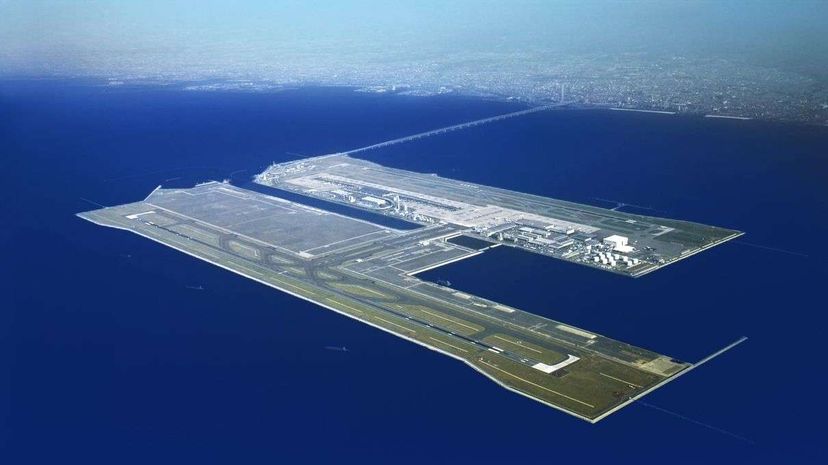
Imagine that it's your job to add more capacity to the air traffic flying in and out of Tokyo. But it's not as easy as adding a runway to the existing airports — there are too many other buildings surrounding these airports. Added to that is a lack of undeveloped, flat ground suitable for a runway. What other option do you have? How about constructing an airport on the water?
If you could build the structure large enough, normal waves wouldn't affect it. It would need to be anchored to land to keep the structure in the right location. It would be an engineering challenge and expensive to build but it might serve as an alternative to bulldozing a neighborhood to make way for a new runway.
Advertisement
It's an idea that engineers have toyed with for decades. Perhaps the earliest proposal along those lines was one in a 1930 edition of Popular Mechanics. The magazine included an article suggesting that airports on long columns could span the Atlantic Ocean at 400-mile (643-kilometer) intervals. The pillars would hold the airport 80 feet (24 meters) above the waves.
We never got around to building those airports but people are still pitching similar ideas. Back in 1995, Tokyo companies formed the Technological Research Association of runway. The group funded an ambitious prototype structure: a runway on a 3281-foot (1,000-meter) artificial, floating island in Tokyo Bay. The island consisted of interlocking pieces, each 984 feet by 197 feet (300 meters by 60 meters) in size. It could withstand impacts, waves and fires. They even conducted successful takeoff and landing tests.
Megafloat was meant to be a test. The team had a much larger goal to build a bigger structure. That has yet to happen but the idea hasn't been completely abandoned.
Meanwhile, over in the U.K. politicians are talking about a similar approach to increase London's capacity for handling flights in and out of the city. This would involve building an artificial island in the Thames estuary. It wouldn't be a true floating airport like the Megafloat facility, but it could help alleviate the problems London has with its current airport capacity. In fact, according to the proponents, this new airport would eliminate the need for Heathrow, meaning London could repurpose the land.
The plan isn't without its critics. Environmentalists worry that the project would have a negative impact on wildlife and ecosystems in the estuary. Heathrow officials are understandably not in favor of the plan.
In the U.S., a similar plan has been proposed for San Diego. The city is in need of a larger airport but doesn't have space to expand the San Diego International Airport. That's a problem, because the airport has only one runway and is the busiest one-runway international airport in the country.
Two companies have proposed a floating airport solution to San Diego's problem. One came from Float Inc., which presented a design back in 1993 (predating Tokyo's Megafloat by a couple of years). City officials debated and largely ignored the plan until formally rejecting the proposal ten years later.
The other plan came from a company called Euphlotea. It's called the O-Plex 2020. If built, it would be a four-story, floating facility containing not just an airport but also office space, hotels and other properties. The proposed airport would have two runways and an underwater light-rail system to get travelers to and from the facility (an alternate proposal relies on high-speed ferries instead).
According to Euphlotea, the whole thing would cost $20 billion. That's a lot of money, but company representatives claim that San Diego will miss out on $100 billion in economic growth if the city doesn't expand its airport by 2020.
Projects this large are difficult to get started even when they involve building on solid ground. It may turn out that we never see a major floating airport. As the expansion problem becomes more urgent, we'll have a better idea if this concept will sink or swim.
Advertisement
